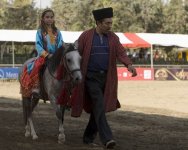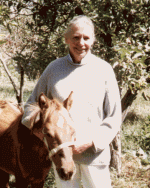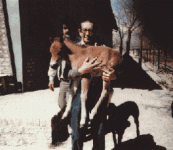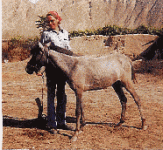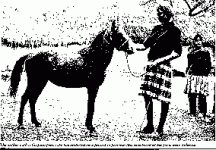پاسخ : لوئيز فيروز
Louise Firouz, the American who rediscovered them, wrote in 1968: "We are still searching for them: diminutive .... Arab looking creatures with big bold eyes, prominent jaws and high-set tails which so distinguish their larger cousins. It has been a losing battle as the already pitifully small numbers are further decimated each year by famine, disease and lack of care, until now we must accept the sad fact that the survivors must number no more than 30."
Mrs. Firouz was writing of her concern that an ancient, pure breed of horse, the forerunner of most hot bloods, until then thought to be extinct, was in fact, on the very brink of extinction. Through neglect, ignorance, and the vicissitudes of the 13 centuries returned to the wild, this ancient breed's honored place in history had been almost irretrievably lost. Only at the last minute and by pure chance, were the existence, beauty, and rarity of this regal horse rediscovered.
In 1957, Louise Laylin, an American born Cornell graduate, married fellow student Narcy Firouz, an aristocrat linked to the former Shah of Iran. She returned with him to his native country of Iran. Subsequently, she and her husband established the Norouzabad Equestrian Center for children of families living in the country's capital of Tehran. One of the difficulties she faced, that of providing appropriate mounts for some of the smaller riders, proved a catalyst for her pursuit of what were rumored to be very small horses in the remote villages above the Caspian Sea. Because hot-blooded stallions were the only mounts available for Tehran's young riders, Mrs. Firouz wanted to provide smaller, more even-tempered equines. Her work would soon result in the rediscovery and preservation of an ancient breed, that she dubbed The Caspian Horse.
In 1965, with a small expedition of female companions, Louise discovered small horses in the mountainous regions south of the Caspian Sea, centered near the town of Amol. At first glance, they appeared somewhat rough from lack of nourishment, and were covered with ticks and parasites. However, upon closer inspection, these horses showed distinctive characteristics similar to the Arabian horse such as large protruding eyes, a prominent jaw, large nostrils, a dished head and a high set tail. This first trip rescued 3 horses, which were dubbed Caspians, for the vicinity in which they were found. The former owners of these often misused and over-worked horses had no idea of the breed's near extinction.
Between July 1965 and August 1968, Mrs. Firouz conducted a careful survey to determine the approximate number and range of the surviving Caspian horses. On the basis of this survey, it was estimated that there were approximately 50 small horses with definite Caspian characteristics along the entire southern coast of the Caspian Sea. The major concentration of these horses (approximately 30) occupied a 2,000 square mile triangle between Amol, Babol and Kiakola in the Elburz Mountains. The remaining 20 horses were so scattered it was impossible for the survey to consider them as completely pure.
Of the horses found, 7 mares, and 6 stallions were purchased to form the foundation stock for a breeding center established by Mrs. Firouz in Norouzabad, Iran. As a purely private venture, this first breeding center was financially difficult to maintain. In 1970, the Royal Horse Society (RHS) was formed under the patronage of the Crown Prince, HIH Prince Reza Pahlavi. The primary aim of the RHS was to preserve and improve Iran's native breeds. The RHS purchased the foundation Caspians, by then numbering 23, but allowed them to be maintained in Norouzabad until 1974, at which time the RHS took over complete management of the herd.
Surviving War and Revolution
Due to the pressing military situation caused by the Iran-Iraq War, and her interest in keeping the breed alive, between 1971 and 1976, Mrs. Firouz exported 9 stallions and 17 mares representing 19 different Caspian bloodlines from Iran to Europe. These 26 horses constitute the European Foundation Herd. This wise decision ensured the survival of the Caspian horse outside of Iran.
Because of her efforts to save the Caspian horses from starvation and slaughter by exportation during the early years of the Islamic Revolution in 1979, Narcy and Louise Firouz were arrested and detained. During this incarceration, Mrs. Firouz was imprisoned while suffering from a broken left ankle, she went on a hunger strike in protest which was successful, but she left prison weak and emaciated.
With Iran's many recent political upheavals, the overthrow of the Shah, the Islamic Revolution, bombing during the protracted Iran-Iraq War and the ever-present threat of famine, together with the Caspian's close association with royalty, the Caspian's survival there remains precarious. Louise Firouz' discovery was ever in the balance between political honoraria as a national treasure, and the threat of political seizure as wartime food. After Mrs. Firouz' breeding successes in the 1960's and early '70's, the Iran-Iraq War placed a heavy burden on her endeavors. The Royal Horse Society of Iran completely took over the Norouzbad herd in 1974. A second private herd was started in 1975, consisting of 20 mares and 3 stallions from feral stock found along the Caspian coast. The breeding center was established by Mrs. Firouz; this time, in northeastern Iran at Gara Tepe Sheikh.
In 1977, this second private breeding center was ordered to close its doors as the RHS declared a ban on all Caspian exports. The RHS collected all Caspians remaining in Iran to breed selectively in a "national stud" to conform to a specific standard of the breed. Forced by the government to surrender all but one Caspian horse, Mrs. Firouz' founding stock was effectively wiped out. Due to the complex political climate, most of the RHS horses were lost, primarily through auction sales of the nationalized horses to Turkoman and Kazakh tribes who used the purchases as pack animals and for meat!
After the war was over, Mrs. Firouz once again completely redeveloped a third breeding center to save the Caspian from extinction in Iran. The 1992 International Caspian Stud Book listed 38 registered Iranian Caspians. Mrs. Firouz obtained most of these horses through either expeditions to the Caspian seacoast to capture more feral horses; purchases from Revolutionary Guards repatriating stolen or seized horses after the Iran-Iraq War, or through breeding.
Undaunted, by political pressure, Mrs. Firouz was able to ship 3 stallions and 4 mares to Europe via the Azeri-American war zone where bandits attacked and robbed the convoy, on across Russia to Belarus, and then to the United Kingdom. These horses which left Iran in July of 1993, reached the United Kingdom in February of 1994. This shipment will sustain and enhance the gene pool and healthy breeding of the Caspian horse established in Europe and the United States.
By 1992, there were still only 112 breeding mares and 30 stallions in Europe. Fortunately, according to the studies completed by Dr. Gus Cothran, the measure of genetic variation among the world-wide Caspian horse population was near the average for U.S. domestic breeds.
Mr. Nancy Firouz passed away in May 1994. Due to estate settlement, and the financial losses Mrs. Firouz incurred in the shipment of the last 7 Caspians out of Iran into England she was unable to continue her breeding program in Iran. The remainder of Mrs. Firouz’s Caspian horses were sold to the Ministry of Jehad. The fate of the Caspian remaining in Iran was once again in jeopardy.
More recently, in 1999, aided by the visits into Iran and support of concerned individuals from Canada and the United States, Louise Firouz, at the age of 65, has started yet another Caspian breeding program on her remote farm at Gara Tepe Sheikh on the Turkoman Steppes next to the Turkmenistan border. During these recent treks in the spring of 1999, two foundation Caspian stallions and eight Caspian foundation mares were gathered to once again be rescued by Mrs. Firouz’ nurturing care. Courageously overlooking her past, seemingly overwhelming losses, she is experiencing the renewed joy of watching the newborn Caspian foals thrive under her ever watchful eye.

